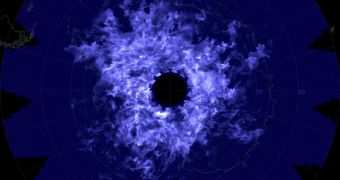For about 130 years, noctilucent clouds have been investigated by researchers around the world, who were trying to make more sense of these peculiar structures. New data are now starting to change the way we understand the formation of such interesting clouds.
They are called noctilucent because they shine in the night – their name is derived from the Latin words for “night” and “shine.” They form at altitudes exceeding 50 kilometers, and require the presence of extremely low temperatures in order to come together.
Interestingly, these silvery blue clouds sometimes can be seen in the sky long after the Sun has set. This led experts to assume that this happened because of the angle at which the stars illuminates high-altitude clouds from way past the horizon line.
But, over the past few years, experts have been keeping tabs on these rare atmospheric formations through the use of the NASA Aeronomy of Ice in the Mesosphere (AIM) mission. Recent datasets collected from the probe reveal that the processes forming noctilucent clouds are changing.
The transition takes place from year to years, and this led experts to believe that the entire planet is involved in the production of these clouds. According to the research team behind the new study, it would appear that changes in global climate patterns are influencing the production of these clouds.
“The formation of the clouds requires both water and incredibly low temperatures. The temperatures turn out to be one of the prime driving factors for when the clouds appear,” explains atmospheric scientist Charles Jackman, who works with the AIM project.
He holds an appointment with the Greenbelt, Maryland-based NASA Goddard Space Flight Center.
In addition to looking pretty, the clouds also provide an unrivaled window of opportunity to study the low-altitude weather systems developing in our planet's atmosphere. Already, AIM has revealed that weather events taking place in one hemisphere have an influence on what goes on in the other.
“The question people usually ask is why do clouds which require such cold temperatures form in the summer?' says the principal investigator of the AIM mission, James Russell.
“It's because of the dynamics of the atmosphere. You actually get the coldest temperatures of the year near the poles in summer at that height in the mesosphere,” adds the expert, who is an atmospheric scientist at the Hampton University, in Virginia.
Scientists even believe now that these clouds could be used as a proxy for determining how winds circulate in the mesosphere. This is due to the close relations that develop between the two.
“They can tell us that the circulation exists first of all, and tell us something about the strength of the circulation,” explains AIM science team member and atmospheric scientist Bodil Karlsson.

 14 DAY TRIAL //
14 DAY TRIAL //